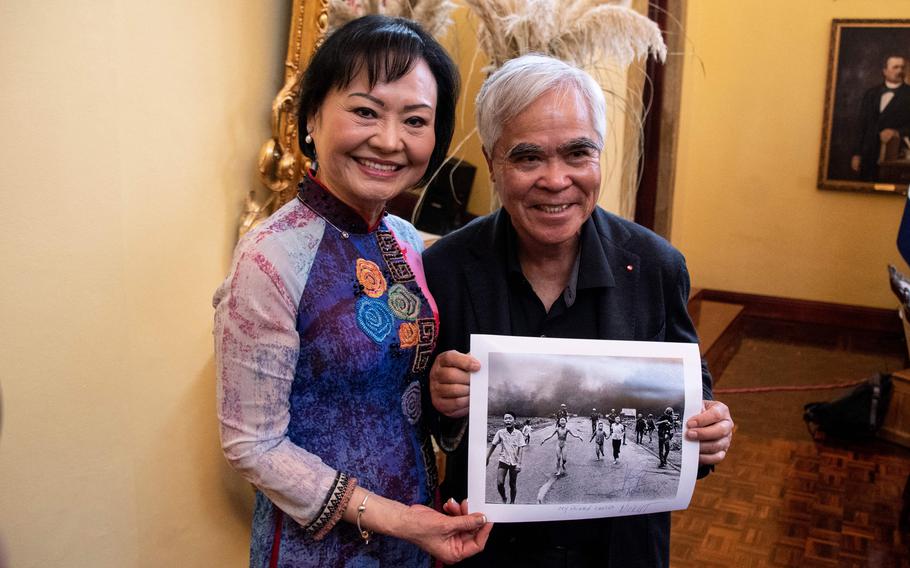
Vietnam War survivor Kim Phuc Phan Thi, left, also known as the "Napalm Girl," poses with photojournalist Nick Ut holding his 1972 Pulitzer Prize and World Press Photo award-winning photograph during the presentation of the Spanish edition of her book at the Ministry of Foreign Affairs and Worship in San José on April 12, 2023. (Ezequiel Becerra, AFP/Getty Images/TNS)
(Tribune News Service) — Pulitzer Prize-winning photographer Nick Ut has spoken out against claims that his famous 1972 photo of a terrified child running from a napalm bomb attack on her village during the Vietnam War was actually taken by someone else.
“I took the photo of (Phan Thi) Kim Phuc,” Ut wrote in a statement Wednesday posted to Facebook. “I took the other photos from that day that show her family and the devastation the war caused. No one else has the right to claim that I did not take that specific or any other photo attributed to me because I am the creator of all the work I’ve done since day one.”
The origins of the photo, officially titled “The Terror of War” but more commonly known as “Napalm Girl,” are questioned in the documentary “The Stringer,” which premiered at the Sundance Film Festival in January.
Directed by Bao Nguyen, the film follows claims made by Carl Robinson — an AP photo editor in Saigon when the image was captured — that he was instructed by Horst Faas, chief of photo operations in Saigon, to incorrectly credit the photo to Ut. The filmmakers’ investigation leads them to Nguyen Thanh Nghe, a driver for an NBC news crew who also was present that day in Trảng Bàng in South Vietnam. Nghe claims in the film that he actually took the famous image, which landed at the AP as a freelancer photo.
“More than 50 years later, I cannot understand why Mr. Carl Robinson, a fellow employee of the AP in Saigon at the time, would make up a story and claim I did not take that iconic photo,” Ut, who retired from the AP in 2017, wrote in his statement. “Why would Mr. Robinson not come forward in the many years before this? Mr. Robinson stood next to me and celebrated the Pulitzer Prize I won on the day it was announced. Mr. Robinson has had ample time to come forward before the key witnesses and those he is accusing of lying passe[d] away.”
Gary Knight, an executive producer on “The Stringer,” told The Times ahead of the premiere that their “story doesn’t hinge on Carl.”
“We interviewed 55 people, 45 on camera, and did the forensic research, which has been tested,” said Knight. “So we don’t rely on Carl’s story. That was just the beginning of the journey.”
The AP conducted its own investigation into the origins of “The Terror of War” prior to the film’s release and concluded, “The AP has no reason to believe anyone other than Ut took the photo.”
In his social media post, Ut said the AP’s system for matching film negatives to photographers in Saigon at the time was “fail-proof” and also credited Haas for helping to get the photo published despite “a lot of pushback.”
“This accusation by Mr. Robinson in my opinion is a slap in the face of everyone who dedicated their entire lives, careers to creating authentic, real and true images in very difficult situations like the Vietnam War,” said Ut.
©2025 Los Angeles Times.
Visit at latimes.com.
Distributed by Tribune Content Agency, LLC.